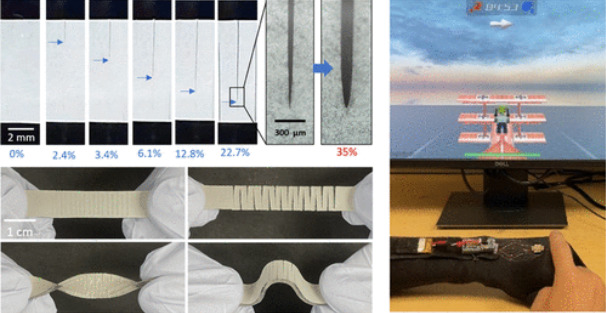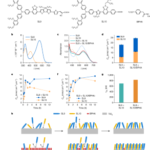2022-01-03 ノースカロライナ州立大学(NCState)
この新しいセンサーは、弾性ポリマーに埋め込まれた銀ナノワイヤーネットワークで構成されています。このポリマーには、一定の深さの平行な切り込みが、材料の左右から交互に入るパターンがある。つまり、左から1つ、右から1つ、左から1つ、というように切り込みが入る。
このセンサーは、電気抵抗の変化を測定することでひずみを測定する。材料が伸びると、抵抗値が増加する。センサーの表面には、伸びた方向に対して垂直な切り込みが入っている。これには2つの効果があります。1つは、この切り込みによって、センサーが大きく変形すること。表面の切り込みがジグザグに引っ張られて開くので、大きな変形にも耐えることができ、破断点に達することがありません。次に、切り口が開くと、電気信号がジグザグを上下に移動し、より遠くまで届くようになります。
論文「Highly Sensitive, Stretchable, and Robust Strain Sensor Based on Crack Propagation and Opening」は、ACS Applied Materials & Interfaces誌に掲載されています。論文の共著者は、NC Stateの博士課程学生であるKatherine Moody氏と、NC Stateの元学部生Abhiroop Kollipara氏です。
<関連情報>
- https://news.ncsu.edu/2023/01/new-stretchable-sensors/
- https://pubs.acs.org/doi/10.1021/acsami.2c16741
亀裂の伝播と開口部を利用した高感度・伸縮・ロバストな歪みセンサ Highly Sensitive, Stretchable, and Robust Strain Sensor Based on Crack Propagation and Opening
Shuang Wu, Katherine Moody, Abhiroop Kollipara, and Yong Zhu
ACS Applied Materials & Interfaces Publication Date:December 22, 2022
DOI:https://doi.org/10.1021/acsami.2c16741

Abstract
Soft and stretchable strain sensors have been attracting significant attention. However, the trade-off between the sensitivity (gauge factor) and the sensing range has been a major challenge. In this work, we report a soft stretchable resistive strain sensor with an unusual combination of high sensitivity, large sensing range, and high robustness. The sensor is made of a silver nanowire network embedded below the surface of an elastomeric matrix (e.g., poly(dimethylsiloxane)). Periodic mechanical cuts are applied to the top surface of the sensor, changing the current flow from uniformly across the sensor to along the conducting path defined by the open cracks. Both experiment and finite element analysis are conducted to study the effect of the slit depth, slit length, and pitch between the slits. The stretchable strain sensor can be integrated into wearable systems for monitoring physiological functions and body motions associated with different levels of strain, such as blood pressure and lower back health. Finally, a soft three-dimensional (3D) touch sensor that tracks both normal and shear stresses is developed for human–machine interfaces and tactile sensing for robotics.




